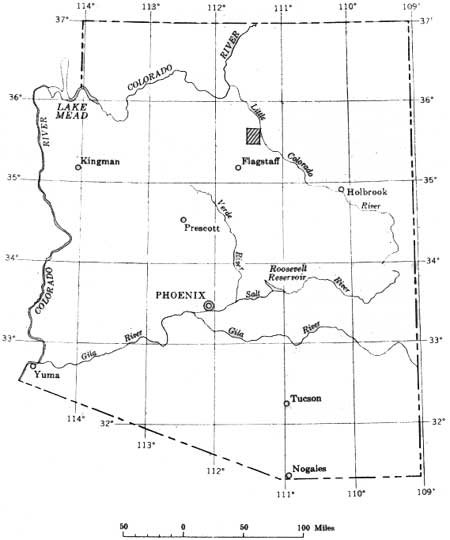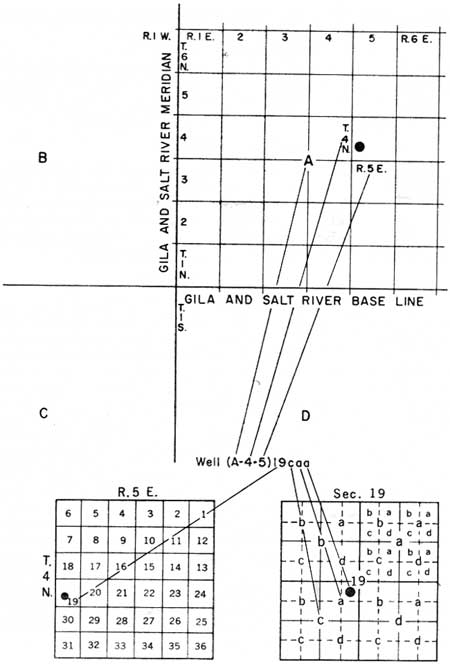
|
Geological Survey Water-Supply Paper 1475-J
Ground Water in the Wupatki and Sunset Crater National Monuments, Coconino County, Arizona |
INTRODUCTION
PURPOSE, SCOPE, AND METHODS OF INVESTIGATION
A ground-water investigation of the Wupatki and Sunset Crater National Monuments was made by the Geological Survey during the fall of 1954, at the request of the National Park Service. The purpose of the investigation was to determine sites favorable for the development of ground water to supply the proposed expansion of National Park Service installations at both monuments. This work was done under the supervision of L. C. Halpenny, then district engineer of the Geological Survey, Ground Water Branch, and was financed by the National Park Service. This report presents the results of the study and of the drilling done on the basis of the administrative report prepared for the National Park Service in 1955.
The investigation was of a reconnaissance nature, and the geologic mapping was done on aerial photographs. The accompanying geologic map (pl. 20) is a compilation of this work and previously published data. An inventory of wells and springs was made, including measurements of water levels, discharge, and collection of water samples for chemical analysis.
LOCATION AND EXTENT OF AREA
The area studied is northeast of Flagstaff, Ariz. (fig. 43). It includes both National Monuments and encompasses about 420 square miles. The Wupatki National Monument, in the northern part, is about 30 miles northeast of Flagstaff and includes about 70 square miles. The Sunset Crater National Monument, in the southern part, is about 15 miles northeast of Flagstaff and includes about 8 square miles.

|
| FIGURE 43.—Map of Arizona showing the Wupatki-Sunset crater area. (click on image for an enlargement in a new window) |
PREVIOUS INVESTIGATIONS
Previous geologic investigations including the areas of the Wupatki and Sunset Crater National Monuments were made by Robinson (1913), Colton (1937), and Childs (1948). A ground-water investigation covering part of the area was made by Feth (1953).
ACKNOWLEDGMENTS
The cooperation and help received from the National Park Service in supplying data from their files, aiding in the collection of field data, and discussing various phases of the work were of great benefit. This assistance, as well as that given by H. S. Colton, Director of the Museum of Northern Arizona at Flagstaff, and the cooperation of ranchers and other individuals, is gratefully acknowledged.
WELL-NUMBERING SYSTEM
The well numbers used by the Geological Survey in Arizona are in accordance with the Bureau of Land Management's system of land subdivision. The land survey in Arizona is based on the Gila and Salt River meridian and base line, which divide the State into four quadrants (fig. 44). These quadrants are designated counterclockwise by the capital letters A, B, C, and D. All land north and east of the point of origin is in A quadrant, that north and west in B quadrant, that south and west in C quadrant, and that south and east in D quadrant. The first digit of a well number indicates the township, the second the range, and the third the section in which the well is situated. The lowercase letters a, b, c, and d after the section number indicate the well location within the section. The first letter denotes a particular 160-acre tract (fig. 44), the second the 40-acre tract, and the third the 10-acre tract. These letters also are assigned in a counterclockwise direction, beginning in the northeast quarter. If the location is known within a 10-acre tract, three lowercase letters are shown in the well number. In the example shown, well number (A-4-5)19caa designates the well as being in the NE1/4NE1/4SW1/4 sec. 19, T. 4 N., R. 5 E. Where there is more than one well within a 10-acre tract, consecutive numbers beginning with 1 are added as suffixes.

|
| FIGURE 44.—Well-numbering system in Arizona. (click on image for an enlargement in a new window) |
| <<< Previous | <<< Contents >>> | Next >>> |
wsp/1475-J/intro.htm
Last Updated: 28-Jul-2007